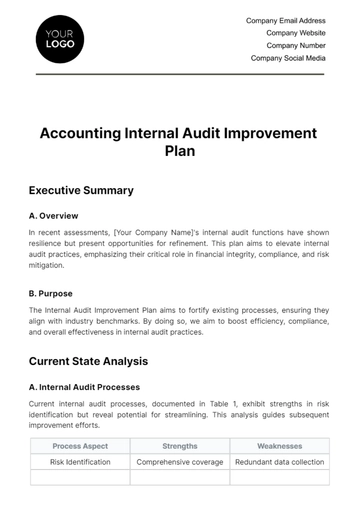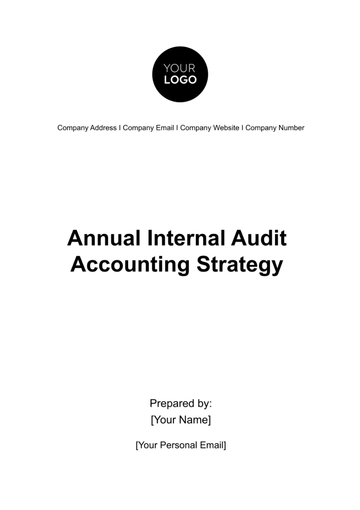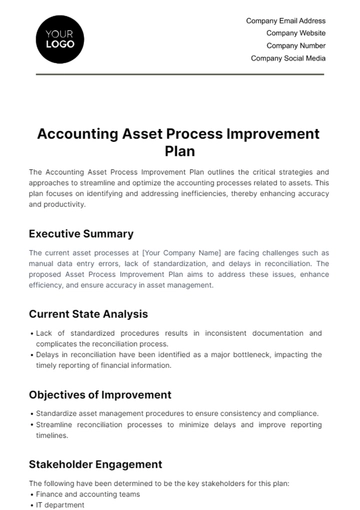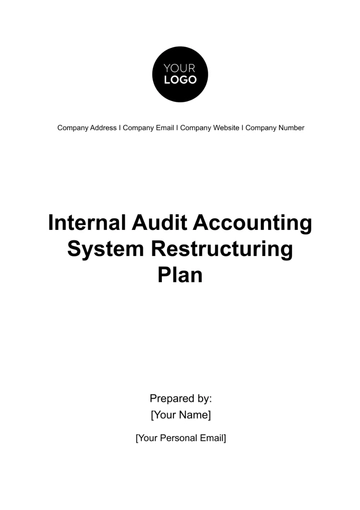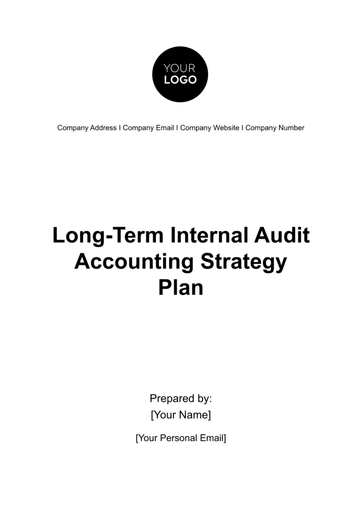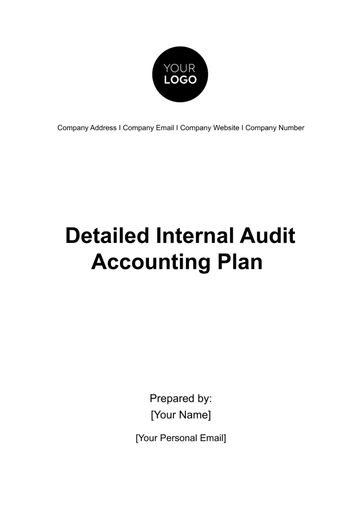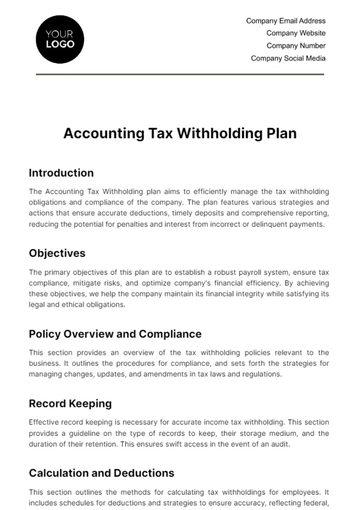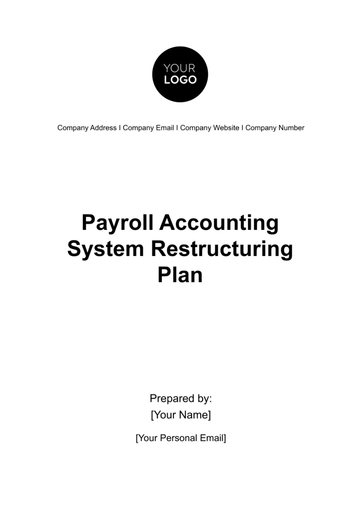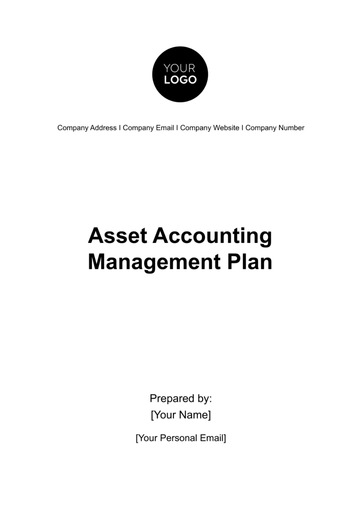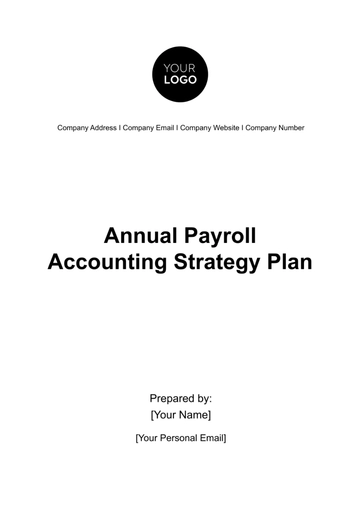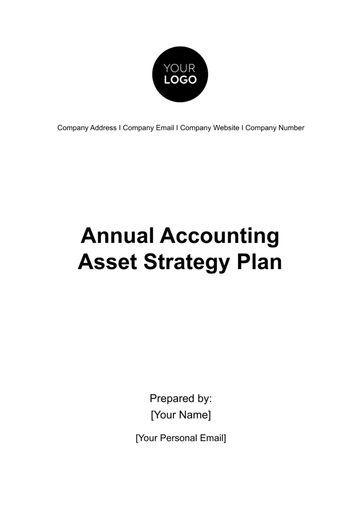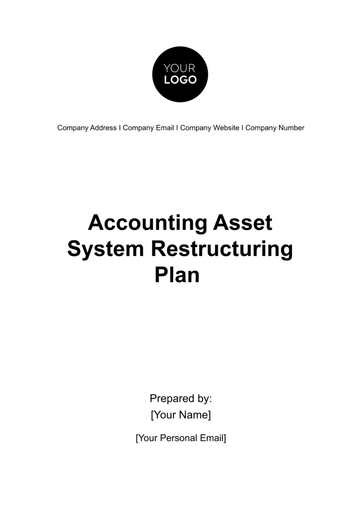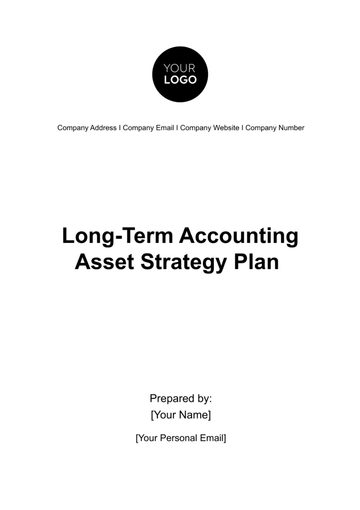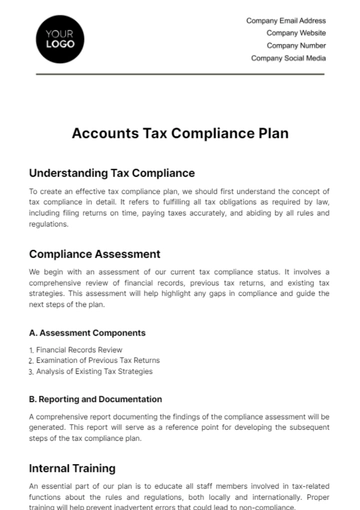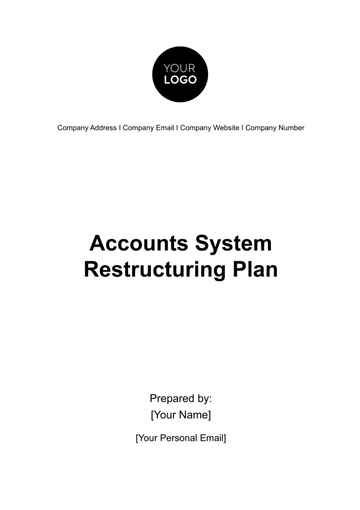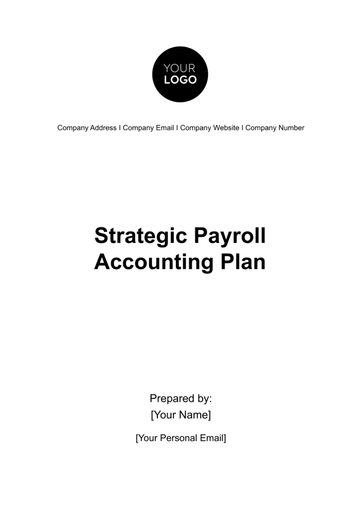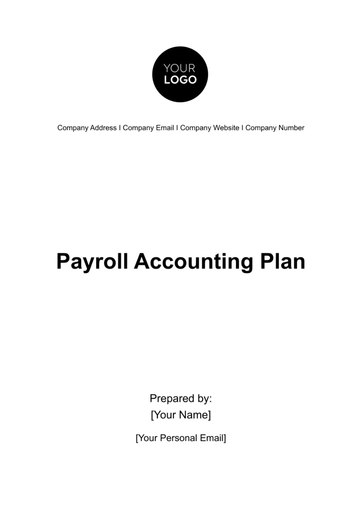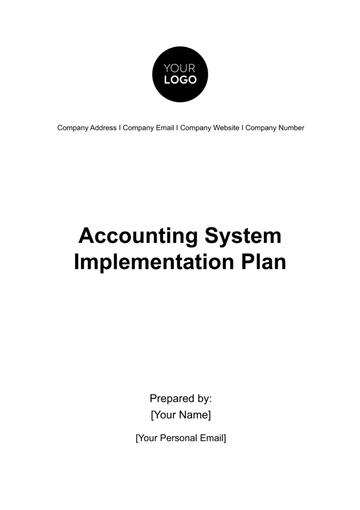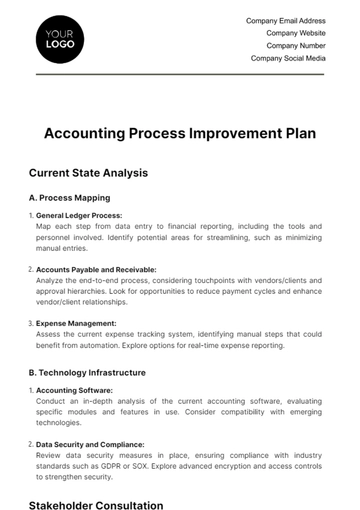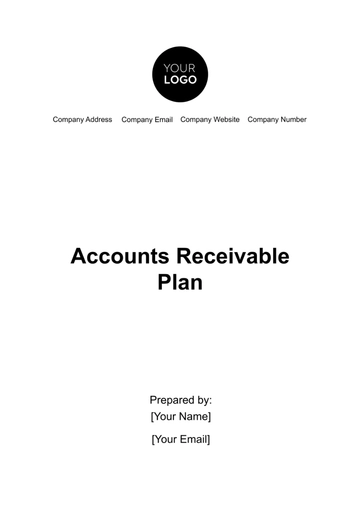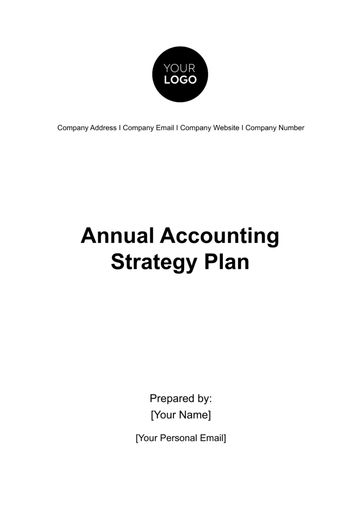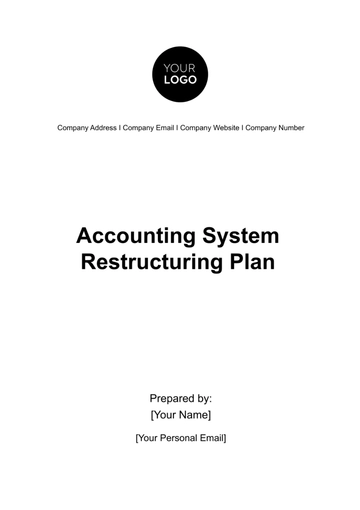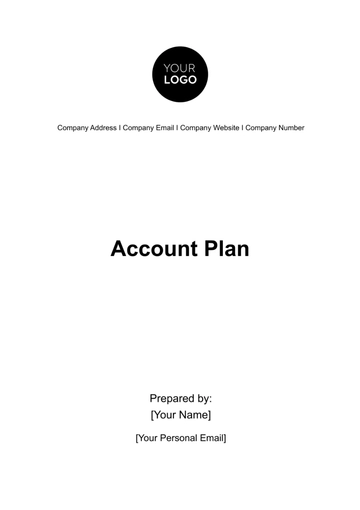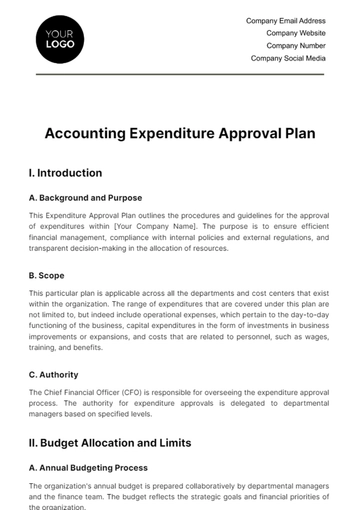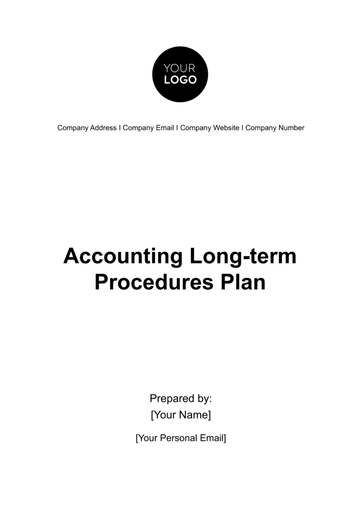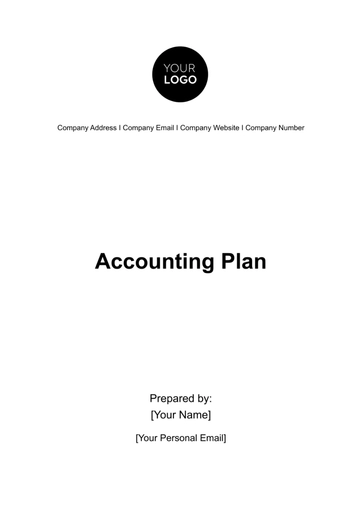Free Accounting System Restructuring Plan
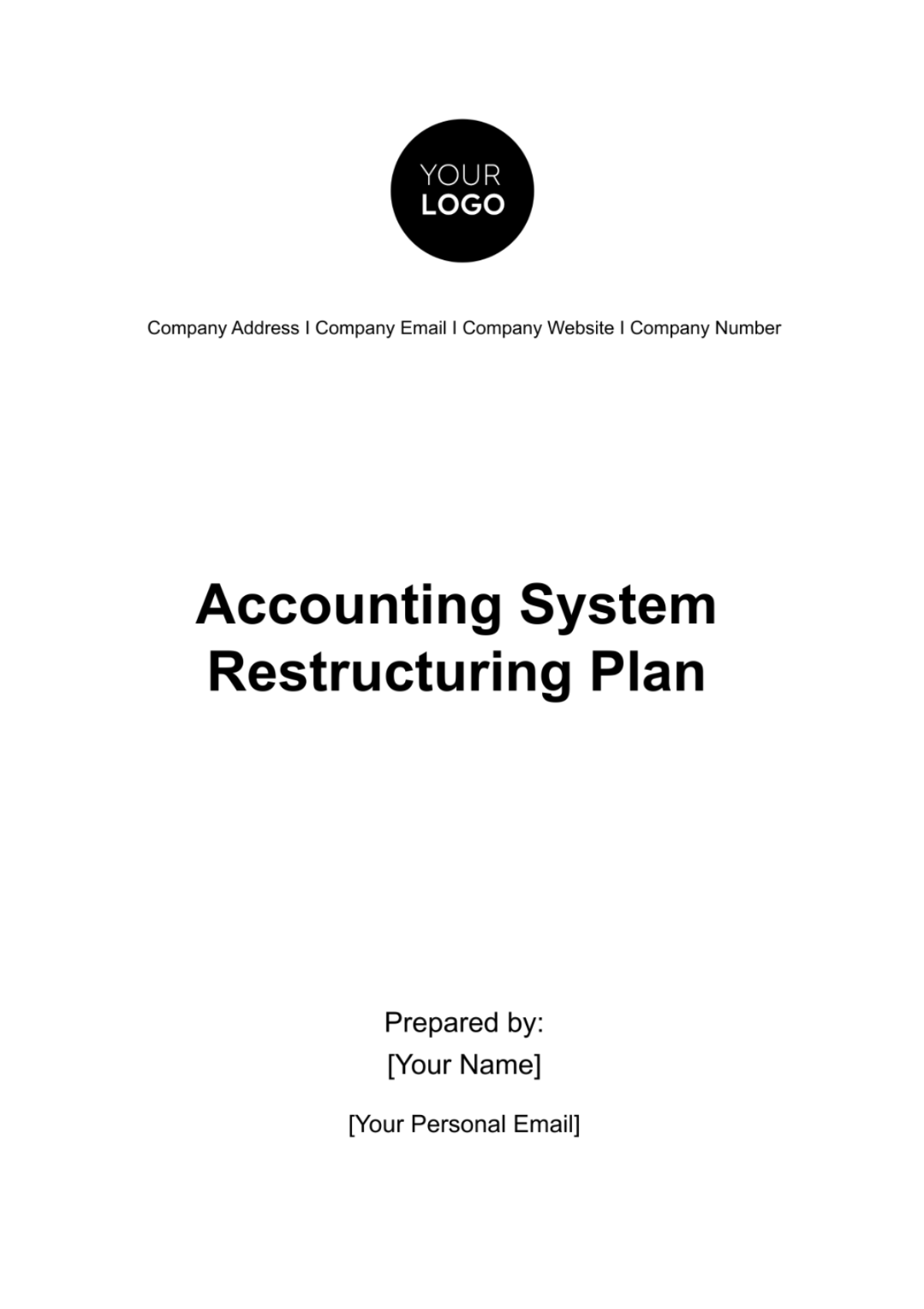
Initial Evaluation
The inaugural phase of our accounting system restructuring plan at [Company Name] commences with a meticulous evaluation of the current accounting framework. This foundational step is critical, as it sets the tone for the entire restructuring process.
The objective of this phase is to conduct a thorough analysis, which includes the following key components:
System Functionality Assessment: A detailed review of the existing software capabilities, focusing on its efficiency in handling various accounting tasks such as invoicing, payroll processing, expense tracking, and financial reporting.
Process Efficiency Analysis: An examination of the current workflows and procedures to identify bottlenecks or inefficiencies. This involves interviewing staff members, observing daily operations, and reviewing process documentation.
Compliance Check: Evaluating the system's adherence to relevant financial regulations and standards. This step ensures that the current setup meets all legal and best practice requirements.
Strengths and Weaknesses Identification: Highlighting what aspects of the current system are performing well and which areas are falling short. This could include user-friendliness of the software, accuracy of financial reports, and the speed of processing transactions.
Opportunity for Improvement Recognition: Pinpointing areas where technology upgrades, process optimization, or staff training could significantly enhance performance.
Risk Assessment: Analyzing potential risks associated with the current system, including data security vulnerabilities and risks of non-compliance with financial regulations.
Benchmarking Against Industry Standards: Comparing the current system with industry best practices and standards to identify areas of improvement.
This in-depth evaluation will provide a comprehensive understanding of the existing accounting system's capabilities and limitations, thereby laying a solid foundation for the subsequent phases of the restructuring plan.
Defining Objectives
Following the initial evaluation, the next critical step in our restructuring plan is to define clear, strategic objectives. These objectives are derived from the insights gained during the evaluation phase and are crucial in directing the course of the restructuring process. The key objectives are:
Enhancing Operational Efficiency: This involves streamlining accounting processes to reduce time and resource expenditure. It includes automating repetitive tasks, improving data entry processes, and simplifying workflow procedures.
Ensuring Regulatory Compliance: The new system must adhere to all relevant financial regulations and standards. This objective prioritizes the implementation of a system that not only meets current compliance requirements but is also adaptable to future legislative changes.
Enhancing Financial Reporting Capabilities: Improving the accuracy, timeliness, and comprehensiveness of financial reports. This includes ensuring real-time financial data availability, facilitating better decision-making, and providing more in-depth financial analysis.
Scalability for Future Growth: The new system should be capable of adapting to the changing needs of [Company Name], including potential business expansion, diversification, and evolving market demands.
Data Security and Integrity: Prioritizing the protection of financial data against breaches and ensuring the integrity and reliability of financial information.
Employee Proficiency and Adoption: Ensuring that the staff is well-trained and comfortable with the new system, thereby minimizing resistance and enhancing overall adoption.
By setting these objectives, we establish a clear roadmap for the restructuring process, ensuring that every step taken aligns with these core goals, ultimately leading to a more efficient, compliant, and robust accounting system for [Company Name].
Selection of Appropriate Technology
Overview
The selection of the right technology for [Company Name]'s new accounting system is pivotal. This process involves a multi-faceted approach, examining various software solutions to determine which best aligns with our predefined objectives.
Criteria for Selection
Functionality: The software must offer comprehensive features that cover all accounting needs, including but not limited to, general ledger management, accounts payable and receivable, payroll, and financial reporting.
Ease of Use: User-friendliness is crucial to ensure quick adoption by staff. The interface should be intuitive, minimizing the learning curve.
Scalability: The technology should be capable of accommodating future growth, both in terms of the number of transactions and the complexity of financial operations.
Cost-Effectiveness: The solution must offer a good balance between cost and features, providing value for money without compromising on essential functionalities.
Integration Capabilities: Compatibility with existing systems and the ability to integrate with other business tools (e.g., CRM, ERP) is essential.
Security Features: Given the sensitive nature of financial data, robust security protocols are non-negotiable.
Technology Evaluation Table
Software Option | Functionality | Ease of Use | Scalability | Cost | Integration Capabilities | Security |
|---|---|---|---|---|---|---|
A | High | Moderate | High | $[Amount] | Excellent | Excellent |
B | Moderate | High | Moderate | $[Amount] | Good | High |
C | High | High | High | $[Amount] | Excellent | Excellent |
System Design Phase
System Structure Creation
After selecting the most suitable technology, we transition to the system design phase. This phase is critical in shaping how the accounting system operates and interacts with other business functions.
Workflow Modeling: We will map out the entire accounting process, identifying key tasks, responsibilities, and checkpoints. This model aims to optimize efficiency and accuracy in financial operations.
Procedure Definition: Clear procedures will be established for each accounting task. This includes standardized methods for data entry, report generation, and reconciliation processes.
Control Setup: To safeguard financial data and ensure compliance, we will implement a series of controls. These include access controls, audit trails, and regular data backups.
Customization: Tailoring the system to meet specific business needs, including custom reports and dashboards for better financial visibility.
Data Transfer Preparations
Ensuring Data Integrity
The success of the new system heavily depends on the quality of the data it starts with. Thus, preparing for data transfer is a vital step.
Data Cleaning: Review and clean existing financial data to ensure accuracy. This involves removing duplicates, correcting errors, and updating outdated information.
Data Validation: Establish a protocol for validating data accuracy and completeness before migration.
Backup and Security: Create backups of all current financial data to prevent any loss during the transition.
Data Handling Guidelines
To maintain data integrity in the new system, we will develop a set of guidelines for ongoing data management, focusing on accuracy, consistency, and security.
Staff Training
Building Proficiency and Confidence
Training is essential to familiarize the staff with the new system, ensuring they are comfortable and proficient in its use.
Training Modules: Develop comprehensive training modules covering different aspects of the new software, including basic navigation, specific accounting functions, and data security protocols.
Workshops and Hands-On Sessions: Conduct interactive workshops and hands-on training sessions for practical learning experiences.
Support System: Establish a support system for ongoing assistance and query resolution. This may include a helpdesk, FAQs, and regular follow-up sessions.
Training Schedule
A structured training schedule ensures systematic and thorough learning for all staff members.
Week | Focus Area | Method |
|---|---|---|
1-2 | Basic Navigation and Interface Familiarity | Workshop |
3-4 | Specific Accounting Functions (e.g., Invoicing, Payroll) | Hands-On Training |
5-6 | Reporting and Compliance | Interactive Session |
7-8 | Data Security and Best Practices | Online Modules |
9+ | Ongoing Support and Advanced Features | Continuous Learning & Support |
By meticulously addressing each of these phases — from selecting the right technology to ensuring our staff are well-equipped to use the new system — [Company Name] is poised to make a successful transition to a more efficient, secure, and scalable accounting system. This comprehensive approach will not only enhance our financial operations but also support the overall strategic objectives of the organization.
System Testing and Validation
Overview
Testing and validation are critical stages in the deployment of the new accounting system for [Company Name]. This phase ensures that the system not only meets the set objectives but also functions seamlessly across various scenarios.
Testing Strategy
Development of Test Cases: Create comprehensive test cases that cover all functionalities of the new system. These cases will be designed to simulate real-world scenarios, testing the system's response and handling of different accounting tasks.
Scenario-Based Testing: Implement scenario-based testing to validate system performance under various conditions, including high data volume processing, multi-user access, and error handling.
User Acceptance Testing (UAT): Involve end-users in the testing process to ensure the system meets their needs and expectations. This step will include a select group of staff from different departments to test the system's usability and functionality.
Performance Testing: Assess the system's performance, focusing on its speed, stability, and resource usage under different loads.
Security Testing: Conduct thorough security checks to ensure the protection of financial data against breaches and unauthorized access.
Validation Process
Functional Validation: Ensure that every feature and function of the system works as intended and meets the outlined specifications.
Data Integrity Checks: Verify the accuracy and integrity of data after migration from the old system to the new system.
Compliance Checks: Confirm that the system adheres to financial regulations and reporting standards.
Testing Schedule and Documentation
Schedule: Outline a detailed schedule for each testing phase, allocating sufficient time for thorough examination and issue resolution.
Documentation: Maintain detailed records of testing procedures, results, identified issues, and how they were resolved. This documentation will be crucial for future reference and ongoing system maintenance.
Feedback and Iteration
Feedback Collection: Gather feedback from users involved in the UAT to understand their experience and any challenges faced.
Iterative Improvement: Implement changes based on feedback and retest as necessary until the system meets all criteria for full-scale deployment.
The testing and validation phase is designed to rigorously assess the new accounting system, ensuring it is robust, user-friendly, and fully capable of supporting [Company Name]'s financial operations without disruptions.
System Implementation
Implementation Overview
The implementation of the new accounting system is a critical transition for [Company Name]. This stage must be meticulously managed to minimize operational disruptions and ensure a smooth changeover from the old to the new system.
Phased Implementation Strategy
Pilot Phase: Initially, roll out the system in a controlled environment or a select department. This allows for monitoring the system's performance in a live setting and addressing any issues before company-wide implementation.
Full-scale Rollout: After successful pilot testing, gradually roll out the system across all departments. This phased approach helps in managing the transition effectively and reduces the risk of operational disruptions.
Parallel Run: Temporarily operate both the old and new systems in parallel. This safeguard ensures that in case of any major issues with the new system, the old system can still be used to prevent any impact on business operations.
Training and Support During Implementation
Refresher Training: Conduct refresher training sessions for all staff members prior to their transition to the new system. Ensure that they are comfortable with its functionalities and workflows.
On-the-Ground Support: Provide on-site support teams to assist staff during the initial phase of the new system implementation. These teams can quickly address any queries or issues that arise.
Monitoring and Adjustments
Continuous Monitoring: Regularly monitor the system’s performance during the implementation phase, focusing on its stability and user feedback.
Adjustments and Optimizations: Be prepared to make immediate adjustments based on the feedback and performance data collected during the implementation phase.
Communication Plan
Regular Updates: Keep all stakeholders informed about the progress of the implementation, including any challenges and how they are being addressed.
Transparent Communication: Maintain open channels of communication for staff to voice concerns or provide feedback during the implementation phase.
Post-Implementation Support
Ongoing Support: Establish a dedicated support system for post-implementation queries and issues.
Documentation and Resources: Provide comprehensive documentation and online resources for self-help and troubleshooting.
The implementation phase is a carefully planned and executed process, ensuring a seamless transition to the new accounting system. By adopting a phased approach and providing ample training and support, [Company Name] is well-positioned to leverage its new accounting system to its full potential, enhancing its overall financial management and operational efficiency.
Post-Implementation Review
Overview
The Post-Implementation Review (PIR) is a critical phase that follows the go-live of the new accounting system at [Company Name]. This review is essential to evaluate the effectiveness of the implementation process and to ensure that the system aligns with the objectives outlined in the restructuring plan.
Objectives of the Review
Assess System Performance: Determine if the system performs according to the specified requirements and expectations.
Evaluate User Satisfaction: Gauge the response of the staff towards the new system, focusing on usability and efficiency.
Identify Gaps and Issues: Recognize any discrepancies between expected and actual outcomes, including technical glitches or process inefficiencies.
Methodology
Data Collection: Gather quantitative and qualitative data through system metrics, user feedback, and performance reports.
Stakeholder Interviews: Conduct interviews with key stakeholders, including management, IT personnel, and end-users, to obtain diverse perspectives.
Comparison with Objectives: Compare the current performance and features of the system against the initial objectives and goals set during the planning phase.
Key Areas for Evaluation
System Functionality: Does the system deliver all the functionalities it was intended to?
Data Accuracy: Are the financial reports and outputs accurate and reliable?
Process Efficiency: Has there been an improvement in operational efficiency?
Compliance: Is the system compliant with the relevant financial regulations and standards?
User Adoption: How well have the users adapted to the new system?
Reporting and Recommendations
Compile Findings: Document all findings, including both strengths and areas needing improvement.
Recommendations for Improvement: Based on the findings, provide actionable recommendations to address any issues.
Plan for Implementation of Changes: Develop a plan to implement these recommendations, including timelines and responsibilities.
The Post-Implementation Review is a valuable tool for [Company Name] to ensure that the newly implemented accounting system not only meets its current needs but is also robust and effective for future operations.
Continuous Monitoring and Update
Overview
Continuous monitoring and regular updates form the backbone of the long-term success of the new accounting system at [Company Name]. This ongoing process ensures that the system not only remains efficient and relevant but also adapts to evolving business needs and regulatory changes.
Monitoring Strategy
Performance Metrics: Establish key performance metrics to regularly assess system efficiency, data accuracy, and user satisfaction.
Regular Audits: Conduct periodic audits to ensure compliance with financial regulations and internal controls.
Feedback Mechanism: Implement a system for collecting and analyzing user feedback for continuous improvement.
Update and Maintenance Plan
Scheduled Updates: Plan for regular updates to the software, including patches and new features, in line with the vendor’s release schedule.
Ad-Hoc Updates: Be prepared for ad-hoc updates in response to changes in financial regulations or business requirements.
Maintenance Schedule: Develop a maintenance schedule to ensure the system remains in optimal condition, including tasks such as data backup and system security checks.
Addressing Evolving Business Needs
Scalability Assessment: Regularly evaluate the system’s scalability to ensure it can accommodate business growth or changes.
Technology Trend Monitoring: Stay abreast of technological advancements and assess their potential impact or benefit to the accounting system.
Training and Development
Continuous Training: Provide ongoing training for staff to ensure they are up-to-date with new features and best practices.
Development Opportunities: Identify opportunities for further development of the system to enhance capabilities or improve efficiency.
Proactive Approach
Proactive Issue Resolution: Establish a proactive approach to identify and resolve issues before they escalate.
Strategic Planning: Incorporate findings from monitoring activities into strategic planning for IT and accounting operations.
Continuous monitoring and regular updates are essential for maintaining the integrity, efficiency, and relevance of [Company Name]'s accounting system. By staying proactive and responsive to changes, the company can ensure that its accounting system remains a powerful tool for financial management and decision-making in the long term.
- 100% Customizable, free editor
- Access 1 Million+ Templates, photo’s & graphics
- Download or share as a template
- Click and replace photos, graphics, text, backgrounds
- Resize, crop, AI write & more
- Access advanced editor
Discover the power of Template.net's Accounting System Restructuring Plan Template! Simplify your financial operations with our AI-driven editor tool that makes customization a breeze. This versatile template empowers you to reshape your accounting system according to your specific requirements. Take charge of your finances with ease and precision. Get started today and revolutionize your financial management!
You may also like
- Finance Plan
- Construction Plan
- Sales Plan
- Development Plan
- Career Plan
- Budget Plan
- HR Plan
- Education Plan
- Transition Plan
- Work Plan
- Training Plan
- Communication Plan
- Operation Plan
- Health And Safety Plan
- Strategy Plan
- Professional Development Plan
- Advertising Plan
- Risk Management Plan
- Restaurant Plan
- School Plan
- Nursing Home Patient Care Plan
- Nursing Care Plan
- Plan Event
- Startup Plan
- Social Media Plan
- Staffing Plan
- Annual Plan
- Content Plan
- Payment Plan
- Implementation Plan
- Hotel Plan
- Workout Plan
- Accounting Plan
- Campaign Plan
- Essay Plan
- 30 60 90 Day Plan
- Research Plan
- Recruitment Plan
- 90 Day Plan
- Quarterly Plan
- Emergency Plan
- 5 Year Plan
- Gym Plan
- Personal Plan
- IT and Software Plan
- Treatment Plan
- Real Estate Plan
- Law Firm Plan
- Healthcare Plan
- Improvement Plan
- Media Plan
- 5 Year Business Plan
- Learning Plan
- Marketing Campaign Plan
- Travel Agency Plan
- Cleaning Services Plan
- Interior Design Plan
- Performance Plan
- PR Plan
- Birth Plan
- Life Plan
- SEO Plan
- Disaster Recovery Plan
- Continuity Plan
- Launch Plan
- Legal Plan
- Behavior Plan
- Performance Improvement Plan
- Salon Plan
- Security Plan
- Security Management Plan
- Employee Development Plan
- Quality Plan
- Service Improvement Plan
- Growth Plan
- Incident Response Plan
- Basketball Plan
- Emergency Action Plan
- Product Launch Plan
- Spa Plan
- Employee Training Plan
- Data Analysis Plan
- Employee Action Plan
- Territory Plan
- Audit Plan
- Classroom Plan
- Activity Plan
- Parenting Plan
- Care Plan
- Project Execution Plan
- Exercise Plan
- Internship Plan
- Software Development Plan
- Continuous Improvement Plan
- Leave Plan
- 90 Day Sales Plan
- Advertising Agency Plan
- Employee Transition Plan
- Smart Action Plan
- Workplace Safety Plan
- Behavior Change Plan
- Contingency Plan
- Continuity of Operations Plan
- Health Plan
- Quality Control Plan
- Self Plan
- Sports Development Plan
- Change Management Plan
- Ecommerce Plan
- Personal Financial Plan
- Process Improvement Plan
- 30-60-90 Day Sales Plan
- Crisis Management Plan
- Engagement Plan
- Execution Plan
- Pandemic Plan
- Quality Assurance Plan
- Service Continuity Plan
- Agile Project Plan
- Fundraising Plan
- Job Transition Plan
- Asset Maintenance Plan
- Maintenance Plan
- Software Test Plan
- Staff Training and Development Plan
- 3 Year Plan
- Brand Activation Plan
- Release Plan
- Resource Plan
- Risk Mitigation Plan
- Teacher Plan
- 30 60 90 Day Plan for New Manager
- Food Safety Plan
- Food Truck Plan
- Hiring Plan
- Quality Management Plan
- Wellness Plan
- Behavior Intervention Plan
- Bonus Plan
- Investment Plan
- Maternity Leave Plan
- Pandemic Response Plan
- Succession Planning
- Coaching Plan
- Configuration Management Plan
- Remote Work Plan
- Self Care Plan
- Teaching Plan
- 100-Day Plan
- HACCP Plan
- Student Plan
- Sustainability Plan
- 30 60 90 Day Plan for Interview
- Access Plan
- Site Specific Safety Plan

